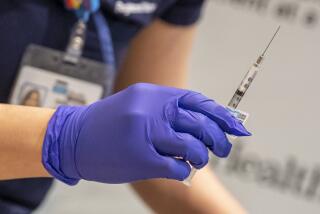Protein Found That Could Lead to AIDS Vaccine
WASHINGTON — Federal public health officials Thursday reported encouraging “candidate material” that could lead to a vaccine to protect against the deadly disease AIDS, but cautioned that testing on humans could not begin until 1988 at the earliest.
Scientists have isolated the major protein found on the envelope--or outer core--of the AIDS virus and have induced antibodies in lower species of animals that were able to kill the virus in laboratory tissue cultures, officials from the Department of Health and Human Services told a press conference.
“I think we’re talking about a natural progression toward a successful vaccine,” said Dr. Peter Fischinger, deputy director of the National Cancer Institute.
‘Long Way to Go’
“We have the antigen”--viral material that stimulates the production of antibodies--and the antigen “does the right stuff,” he added. “I think that’s progress. But we have a long way to go.”
He said that the glycoprotein, which is a protein covered with sugar, was used to inoculate a series of animals, including goats, rabbits, mice and guinea pigs, all of which developed so-called “neutralizing” antibodies that were able to kill HTLV-III, the virus that causes acquired immune deficiency syndrome, in the laboratory. The glycoprotein is known as GP120.
Fischinger said that experiments on higher species of animals, such as rhesus monkeys, had already begun and that “we are working our way up the evolutionary ladder” to chimpanzees. He said that human trials could begin once scientists have demonstrated that chimpanzees, which are susceptible to viral infection, could be injected with the GP120 and produce neutralizing antibodies that protect them from “a challenge” from the virus.
“That’s do-able and we’ll know fairly soon,” he said. But he added: “If everything goes absolutely right at every step, we cannot start considering any kind of human testing before some time in 1988. That would be the earliest possible date.”
‘Very Promising’
Dr. Dani Bolognesi, deputy director of the cancer center at Duke University Medical Center, who collaborated with National Cancer Institute researchers on the GP120 work, called their development “very promising” but agreed that a human vaccine is several years away.
“A vaccine may take some time, even if we had it today,” he said in a telephone interview. “We have to prove it’s safe and we have to prove it’s effective against different strains (of the virus). It will take a long hard road--it’s not going to move as quickly as any of us would want.”
Bolognesi said that one of the obstacles remaining is to identify the site on the protein that is common to all strains of HTLV-III so that a potential vaccine would produce protective antibodies against all forms of the virus.
“One has to take pieces of this thing and find which is the common denominator,” he said. “We have some good guesswork going on--the possibility of finding the site looms very bright.”
Fischinger said that another major problem with GP120 is “that it has been very difficult to isolate this molecule in any sizable amounts.”
Genetic Engineering Role
Bolognesi added: “To get enough material, if it will ever result in a vaccine, there will have to be a tremendous amount available. Genetic engineering will have to play a dominant role there.”
Government health officials, also reporting on the progress of treatments for AIDS, said that an experimental anti-viral drug called azidothymidine, or AZT, which is manufactured by Burroughs-Wellcome, had shown some “promise” and would be expanded into wider human trials. AZT can be taken orally, they said, and is one of the rare drugs able to penetrate the body’s natural “blood-brain barrier” to reach the brain, often a site of HTLV-III infection.
“What has been learned from the early trial does give us some cautious optimism,” said Walter Dowdle, AIDS coordinator for the Public Health Service.
AIDS destroys the body’s immune system, leaving it powerless against rare infections, cancers and neurological disorders. It is transmitted through intimate sexual contact and the sharing of unsterilized hypodermic needles.





